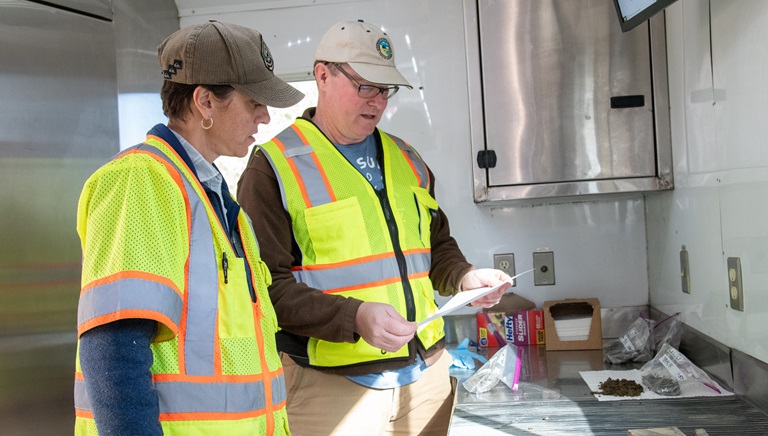Groundwater Management is a Team Effort at DWR
(left to right) Katy (Margaret) Janes and Mark Souverville, engineering geologists for the California Department of Water Resources, review data collected during Cone Penetrometer Testing (CPT). DWR/2019
In California, groundwater is a precious resource that supports the health of our communities, the economy, and the environment.
Groundwater is critical to ensuring a more resilient water future for California, explained Taryn Ravazzini, Deputy Director, Statewide Groundwater Management, with the Department of Water Resources (DWR). Not only does it represent more than half of the state’s water supply in dry years, it is the only source of drinking and irrigation water for many communities, she added.
The Sustainable Groundwater Management Act (SGMA), passed in 2014, placed DWR at the helm of this new framework for managing the state’s groundwater.
Staff in the Sustainable Groundwater Management Program are responsible for implementing SGMA. Besides reviewing and making final determinations on submitted plans that show how local agencies will manage their groundwater basins for long-term sustainability, DWR staff provide essential resources to local water agencies to help them better understand and manage their local basins. Staff create statewide datasets and tools, develop guidance documents and reports, install monitoring wells and stream gauges, support innovative technologies to measure subsidence, and more to achieve statewide groundwater sustainability.
There are also hundreds of DWR staff members throughout the state who contribute the best of science, engineering, and innovation to support groundwater management.
“Groundwater Awareness Week is a great opportunity for DWR to showcase the important work that our professional engineering geologists, engineers, and environmental scientists do in support of sustainable groundwater management as well as highlight the key role of groundwater in the daily lives of Californians,” Ravazzini said.
Below are some examples of DWR staff contributions to groundwater management:
- DWR’s investment by the Division of Flood Management in a 21st century precipitation monitoring network for atmospheric rivers is enabling better skill in weather forecasting, leading to development of several pilot projects on forecast-informed reservoir operations (FIRO). Where FIRO can be implemented, more efficient reservoir operations can improve flood response capability while at the same time potentially allowing water agencies to either retain more water in reservoir storage in dry years or better time reservoir releases to downstream groundwater storage projects to increase the amount of water stored. Additional efforts to improve forecasting at longer lead times (several weeks to months, called sub-seasonal to seasonal forecasting) to support drought management would further expand the ability to implement FIRO.
- Flood-Managed Aquifer Recharge (Flood-MAR) is a promising, innovative strategy to take advantage of excess floodwater and high snowmelt runoff, when available, to redirect those high flows to agricultural lands for opportunistic groundwater recharge. Using these working lands for recharge in wet years effectively expands the state’s ability to store groundwater, supporting local agency implementation of SGMA. California’s aquifers can store more water than the state’s surface water reservoirs, even as much as 20 times more.
- DWR’S Division of Environmental Services gathers scientific information used to support water and resource management throughout the state. This information can be used by local agencies in their plans which map out how they will manage their groundwater for long-term sustainability.
- DWR’s Integrated Regional Water Management staff members work with regional water managers to identify and implement water management solutions that increase regional self-reliance, reduce conflict, and manage water to achieve social, environmental, and economic objectives.
- DWR offers a number of grant and loan programs – including the Sustainable Groundwater Management Grant Program – that support integrated water management activities addressing environmental stewardship, water supply reliability, public safety, and economic stability. The grant programs fund planning, implementation, and disadvantaged community involvement.
- The Water Use & Efficiency Program helps agencies and individuals conserve agricultural and urban water which in turn helps preserve our state’s precious groundwater resources.
- The Delta Conveyance Project would transfer excess seasonal flows directly to the state water project. That water would then be transferred to reservoirs or to water contractors where it could be released and used for groundwater recharge, water banking and other groundwater related functions.
“Because groundwater is not visible, it is easily taken for granted and also presents challenges to understanding basin conditions. DWR plays a vital role in helping to educate the public on the importance of groundwater, and how to manage it sustainably,” Ravazzini said.
